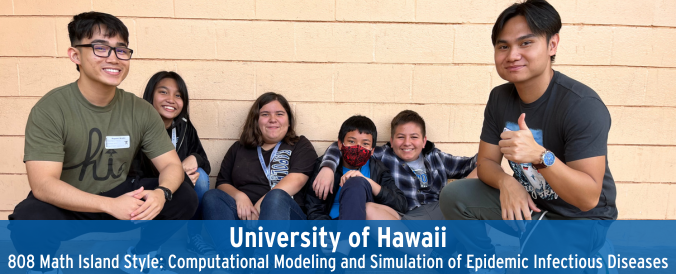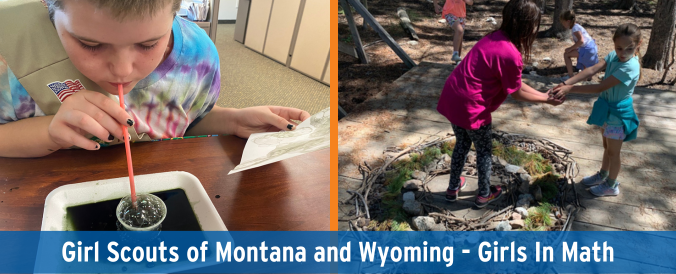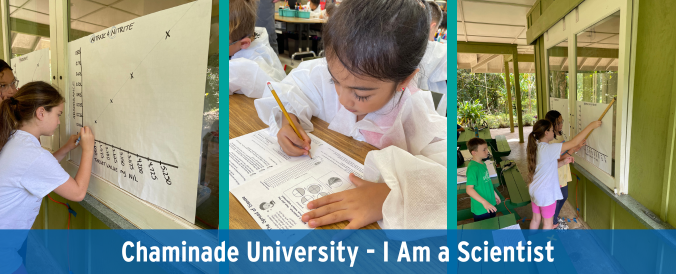- About MAA
- Membership
- MAA Publications
- Periodicals
- Blogs
- MAA Book Series
- MAA Press (an imprint of the AMS)
- MAA Notes
- MAA Reviews
- Mathematical Communication
- Information for Libraries
- Author Resources
- Advertise with MAA
- Meetings
- Competitions
- Programs
- Communities
- MAA Sections
- SIGMAA
- MAA Connect
- Students
- MAA Awards
- Awards Booklets
- Writing Awards
- Teaching Awards
- Service Awards
- Research Awards
- Lecture Awards
- Putnam Competition Individual and Team Winners
- D. E. Shaw Group AMC 8 Awards & Certificates
- Maryam Mirzakhani AMC 10 A Awards & Certificates
- Two Sigma AMC 10 B Awards & Certificates
- Jane Street AMC 12 A Awards & Certificates
- Akamai AMC 12 B Awards & Certificates
- High School Teachers
- News
You are here
Neff Outreach Fund
The John and Mary Neff Foundation have provided funding to support projects designed to encourage middle school students to study and persist in their interest in mathematics. During the summer of 2022, the MAA partnered with the Neff Foundation to offer a pilot outreach program that serves middle school students in rural and indigenous communities. The MAA is proud to announce that after a successful pilot year, the Neff Outreach Fund has now become a mainstay within our outreach initiatives. Through the MAA outreach initiatives, MAA strives to offer support to faculty and program directors to offer math education projects to elementary, middle school, high school and early college students. We are excited to offer this additional funding resource to help promote the importance and implementation of programs that will further students studies in mathematic education.
Proposals are sought from higher education institutions, school districts, or nonprofit organizations establishing projects that actively engage elementary, middle or high school students beyond the standard curriculum. The Foundation is particularly interested in projects that directly support students from underserved communities, rural communities, and/or indigenous communities.
About the Program How to Apply Previous Awardees Contact Us
About the Program
Projects should provide enrichment and extension activities for students which lead to heightened interest in and appreciation of mathematics. The projects should encourage students to continue their studies of mathematics in high school and college and should better prepare them for those studies. Projects should be fun and designed to provide active enrichment activities, beyond classroom coursework. The project should target populations and communities that are in high need of funding resources to offer educational enrichment opportunities. We are interested in seeing projects that are in rural areas, communities of color, and/or high-need schools.
Projects should be conducted over a sufficient period of time to engage student participants in learning and applying new and interesting mathematics that they will not otherwise encounter in their classes. Projects may be conducted during summer, during the school year, on weekends, or after school.
Sample Projects
- Organize a club for students interested in mathematics
- Develop a Math Circle for elementary, middle or high school students
- Conduct a summer mathematics camp for middle and/or high school students
- Organize a speaker series for elementary, middle or high school students on mathematical enrichment topics and career opportunities using mathematics
- Actively engage students in a way they have not been in school
- Organize a project that connects students with a problem based on real applications in industry
Nature of the Grant
Grants will be up to $6,000 and will be made to the institution/organization of the project director for a one-year project. These grants will not support any institutional indirect costs or provide fringe benefits. To provide maximum flexibility, if by the end of your project there are unexpended funds, you may request a no cost extension to allow additional time to spend down grant funds. Some grants may be renewed up to a maximum of three total years of funding.
How to Apply
To apply for an MAA Neff Outreach Fund Grant you must submit an application through Amplifund, our online application portal. You will need to create a free account within the Amplifund system. If awarded, this account will be used to administer your award, so please be sure to enter all of your contact information correctly. We will notify applicants of their status at the end of April.The application portal for 2024 is now closed.
How to Create an Amplifund Account
On the "Application Details" page, click "Apply". On the next screen, click "Register". Enter the information as requested, and read and accept the terms and conditions. You may now complete your application.
Getting Started with Amplifund
Get started with Amplifund by watching this video. You will learn about setting up an account, completing an application, and submitting an application.
Who May Apply
Applications will be accepted from college and university mathematical sciences faculty at accredited U.S. (including U.S. Territory), school districts, and nonprofit organizations. For those applicants from higher education institutions, they are encouraged to demonstrate a partnership with a secondary or middle school mathematics faculty that is appropriate for the project. Either the middle or high school teachers or the college or university faculty may initiate the project and teachers are encouraged to develop ideas and to contact colleagues at a nearby two- or four-year college or university to work collaboratively.
Characteristics of Effective Projects
While projects will have a high degree of variability, there are some characteristics which effective projects will share:
- Distinct, fresh, and innovative
- Plans for successfully recruiting and retaining students participants from high need schools;
- Clearly articulated and measurable project objectives;
- Strong academic component beyond the standard K-12 curriculum, with a focus on enrichment;
- Actively engage students in the activity and in mathematics;
- A clearly defined activity that engages students in the process, structured in a way to have a positive impact on the student;
- Highly competent project team;
- Strong mentorship component among students and/or teachers
- Make it fun!
- Demonstrate practical application of math concepts
- Use technology to improve math and critical thinking skills
Projects may also include mentoring of student participants, involvement of parents, teachers, and counselors, or a peer support system.
Application Requirements
A proposal for a project may be submitted to only one of the following MAA grant programs in a given year: the Neff Outreach Fund, the DMEG program; the Tensor SUMMA program; or the Tensor Women and Mathematics program. If submitted to multiple programs, the MAA and Project Directors will reject the project from all but one. Multiple proposals from the same department or institution (each for a different project and with a different project team) may be submitted to the same grant program in the same year.
Please be prepared to include the name and mailing address of a Financial Officer in charge of this grant. The Financial Officer should be a person in your institution who will accept the award check for this grant, ensure that the funds are available to the project team, and help the Project Director with preparing the final expenditure report on the project. At most institutions, this is someone in the Sponsored Programs Office.
Make sure you have the following documents ready as separate PDF files as you will be asked to upload them in appropriate sections of your application:
- CVs of Project Director and any Co-Directors (2 page limit per CV);-
- A Proposal Narrative, as specified below;
- Letter(s) of Recommendation from your department chair or other appropriate administrator indicating institutional support of the project and other relevant documents.
Upon applying for your grant, you will have the opportunity to download the full application to gain insight into all the information that will be required for a successful application. We encourage applicants to do this before applying.
Proposal Narrative
The following guidelines should be addressed in the order (5 page limit):
- Concept: Describe the mathematical and educational concepts and activities that form the basis for the project. Include a description of the activities, the frequency, how many students are expected to participate, how the project will attract students, how students will be selected, who will oversee the project, and who will lead the activities. Specify the intended audience and how participants will be recruited; projects must be open to all students who interest in mathematics. Provide details on the type of mathematics and topics covered and how students will be actively engaged.
- Objectives: List the objectives and how they will be achieved by the project
- Evaluation: Describe how you will judge the success of the project. If this project has run before, please provide details on the number of students, assessment of the project, and how the Neff funds would be used to expand or enhance the project.
- Timeline: Include a timeline of significant project activities.
Project Budget
During the course of the online application, you will be asked to submit a proposed budget for your project. There will be a fillable budget template for you to complete. Each line item in your budget will have a section for you to include comments to explain the cost of the item and why it is necessary for the project's activities. Proposals that focus spending on project participants are found more favorable.
Frequently Asked Questions
Yes, you will need to create a free Amplifund account in order to apply.
The exception to this would be if your institution already has an Amplifund account. Amplifund is the grants management system for many organizations, not just MAA, so it is possible that your institution’s grants office, or sponsored programs office, has an account for your institution already. If that is the case, please contact that office directly.
On the Opportunity Details page, you will see a button that says “Apply” in the upper right of the screen. Click on “Apply” and then click “Register” on the next screen. You will be asked to enter some information about yourself and your organization (note: for academic institutions please select “Other” as organization type), and then you will be asked to accept the terms and conditions. Once this is complete, you may begin your application.
When setting up your Amplifund account you will be asked for your organization name and type. This organization will be the fiscal agent for the grant you are applying for (usually a college/university). For organization type, most academic institutions should select “Other” unless they are applying as a Foundation or Corporation. If you’re unsure, please contact your grants or sponsored programs office.
No, each institution/college/university should only create one account that everyone should use to apply. We suggest that you contact your grants or sponsored programs office directly to coordinate this.
This should be the title of your project, i.e. “[University Name’s] Math Circle” or “Girls Doing Math Camp”, etc.
Yes! At any point while you’re filling out the application form you can download the application in its entirety. Additionally, before submitting, on the final screen there will be a button that says “Review” with a download arrow. Click on this button to download your completed application before submitting.
Amplifund has a built-in safety feature to prevent applicants from missing sections. Each page/section of the application needs to be “Marked as Complete” in order for the system to register that it is in fact complete. There is a button at the bottom of each page/section called “Mark as Complete”. Make sure you have clicked this on each page (when clicked, the button becomes “Mark as In Progress”).
You will receive a confirmation email at the email address you used to create your Amplifund account.
Funding for all four programs is limited, and the MAA will make every attempt to support a broad range of projects from various geographic locations. If any department is interested in submitting more than one proposal, we strongly recommend discussing this internally; the proposals must support different programs and must have different personnel.
No, they don’t need to be MAA members. While project personnel credentials are a factor in making a funding decision, their MAA membership status does not affect their chances of getting a grant.
CV is limited to two pages per EACH of the project co-directors.
Your budget may not pay for release time for faculty. It is assumed that this will be covered by your university as in-kind contribution.
At this time, the Neff Outreach Fund only accepts applications from the US and US territories.
Program Contacts
For additional information, please contact MAA Progams .







